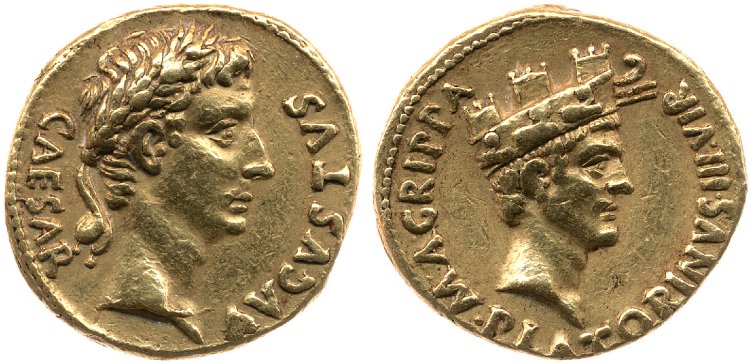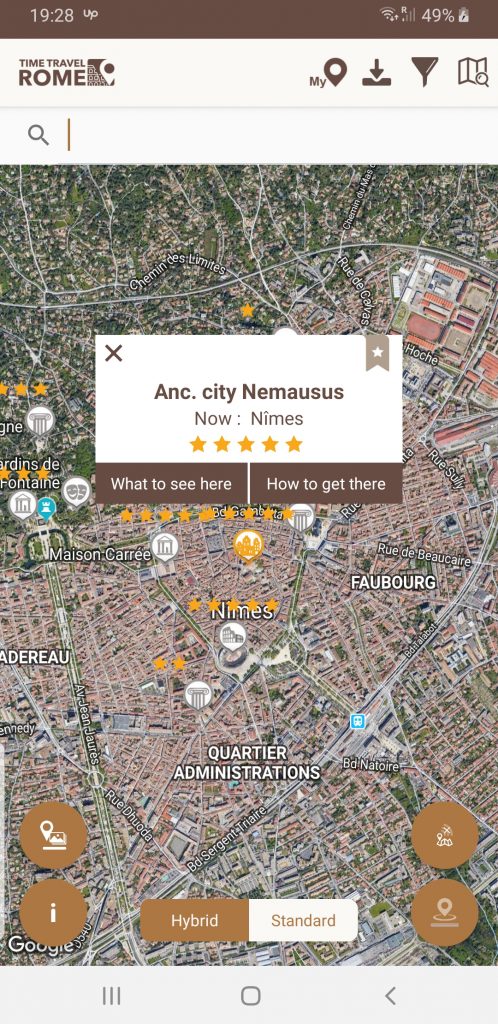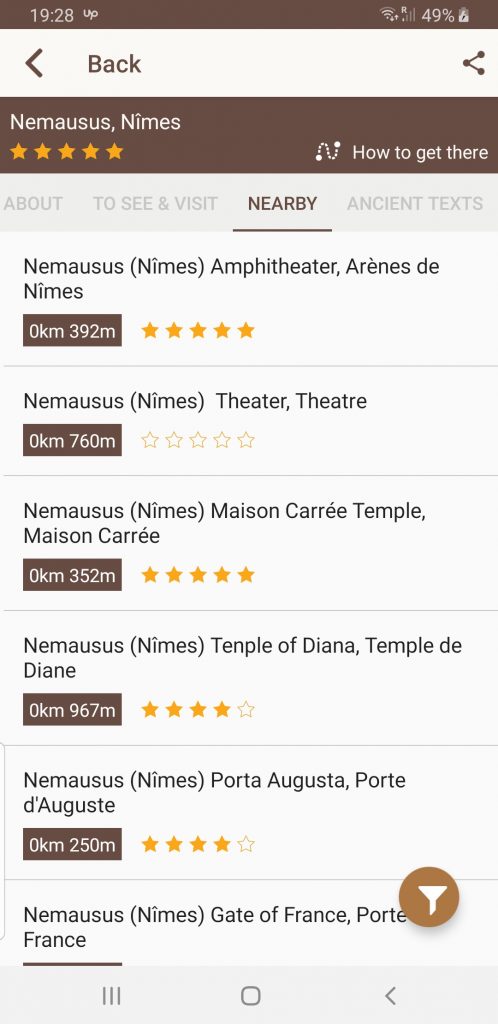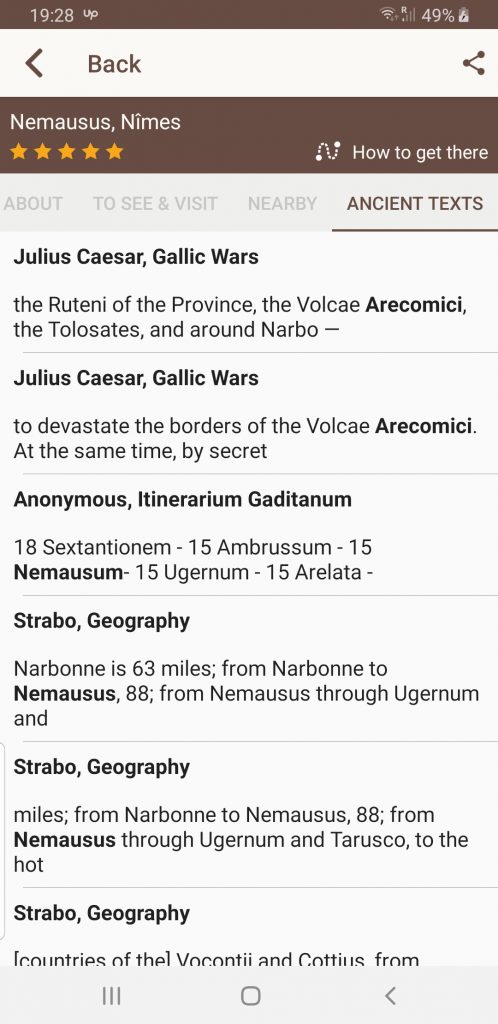“Agrippa, favoured by the winds and the gods leads his towering column of ships, his brow shines with the beaks of the naval crown, his proud battle distinction”
Virgil, Aeneid. Book VIII (translation by A.S. Kline)
Agrippa is one of the greatest men of Ancient Rome. His lifetime accomplishments were spectacular and his heritage is incredibly rich even two thousand years after his death. However, only a few Roman coins issued during his lifetime bear his portrait or name. This is due to the role that money played at the time of the Roman Empire. In addition to being a means of payment, coins were also a form of propaganda. As this centered around the person of Octavian, and later his family, other subjects or persons, with rare exceptions, had no place on Rome’s coins.
Yet numerous coins were dedicated to Agrippa or bear his name. Below are some of these coins, each linked to a relevant ancient roman place or monument.
Crocodile on coins from Nîmes
The founding of Nîmes in southern Gaul goes back to the sixth century BC. At this time, Volcae Arecomici, a Celtic tribe, settled there around a spring and built a sanctuary. In 120 BC, the Volcae accepted the Roman legions without resistance, eventually giving birth to the town of Nemausa.
The development of the city surged during the imperial times when the city became a roman colony. After the Battle of Actium in 31 BC, marking the victory of Octavian and Agrippa over the fleets of Mark Anthony and Cleopatra, Octavian demobilized some of his legions and many veterans came to settle in Nîmes. The city changed status in 24 BC, becoming a Roman colony under the name of “Colonia Augusta Nemausus.” The very important minting that started from 27 BC shows the commercial dynamism of the city which became one of the richest in the region.
The famous dupondius struck in Nemausus starting in 27 BC depicts back-to-back heads of Augustus and Agrippa and legend IMP DIVI F on the obverse, and a crocodile chained to a palm, flanked by legend COL NEM, on the reverse. Agrippa and Augustus appear together on these coins because they were the patrons of Nîmes. Agrippa is also believed to be the architect of Nîmes’ main architectural features. On the reverse of the coin, the crocodile chained to a palm tree symbolizes Egypt’s submission to Rome.
The palm is an attribute of Apollo, the “patron” god of Octavian, a sanctuary in Apollo was also located opposite the site of the Battle of Actium. Many of these coins have also an abbreviation P.P. on them (as on the coin below – beside Augustus and Agrippa’s portraits). The abbreviation is believed to mean “Patronus Parentes” reflecting the role that Augustus and Agrippa jointly played in the prosperity of the colony.
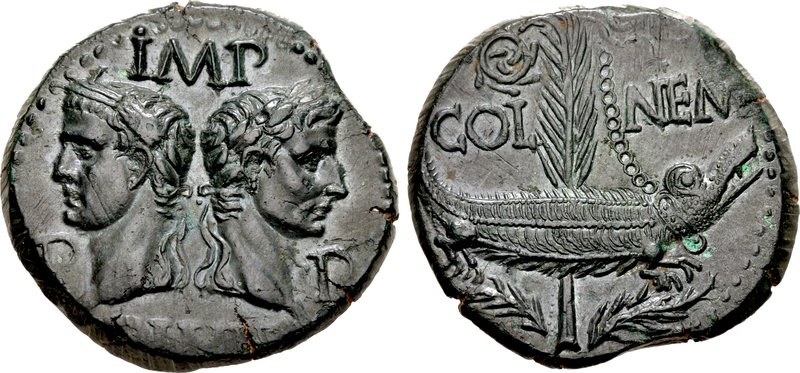
Dolphins on coins from Nicopolis
Besides Nîmes, numerous cities and towns in Italy, Spain, Greece, and throughout the East dedicated statues to Agrippa, selected him as patron, and bestowed honorary offices upon him (“Marcus Agrippa. A Biography”, Meyer Reinhold pp. 102-103).
One of such cities was Nikopolis (var: Nicopolis) in Epirus. Named as the “City of Victory,” Augustus founded Nikopolis to “extend the fame of his victory at Actium and to perpetrate its memory” (Suetonius, Aug. 18,2). The foundation of Nikopolis was not dictated solely by the desire to commemorate the victory. It also served a strategic purpose guarding the narrowest point of the peninsula which closes the Gulf of Arta.
Bronze coins minted there depict Agrippa’s bare head on the obverse, while the reverse shows a dolphin entwined around a trident. The reverse of the coin is a clear allusion to the naval victories of Agrippa at Actium. Sea-related symbols represent a recurring pattern in Agrippa heritage. The colossal statue in Venice shows Agrippa leaning on a dolphin and dolphins. Cockle-shells, and tridents decorated the friezes of his Baths in Rome. Agrippa even installed seven bronze dolphins to mark laps for the charioteers on the Circus Maximus.
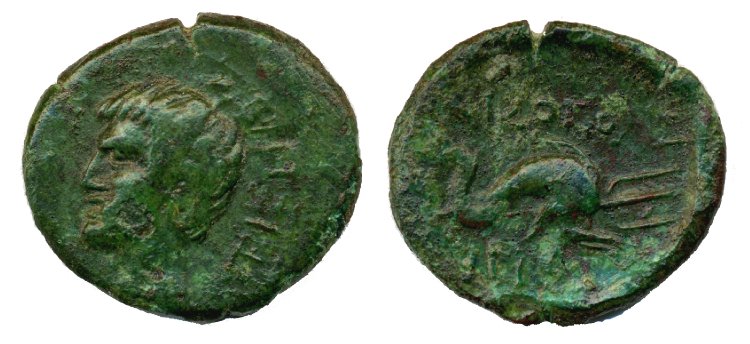
Empty seat on Rostra
The Rostrum that can be seen today was installed on its current location by Julius Caesar in 44 BC. Then, around 29 BC, Augustus modified the structure. He extended the curved platform backwards to form a rectangle. Augustus also built a second rostrum in 29 BC in front of the Temple of Caesar. This structure also decorated with the prows of galleys captured during the great naval Battle of Actium. During this battle, Augustus’s fleet destroyed the forces of Marc Antony and Cleopatra. His victory cleared the way to his absolute power.
It is possible that coin below depicts this second rostrum as it then appeared. Indeed, this denarius was struck in 13 BC, after the second rostrum was built and only three prows can be seen here, while the “old” rostrum counted six. In addition, the coin is related to Agrippa, who was instrumental in the Actium victory. It is believed that the coin commemorates the renewal of Agrippa’s appointment as tribune (his first appointment was in the 18 BC) together with Augustus, but the whole series of coins struck in 13 BC suggests that the ambition was even broader: Agrippa was positioned on these coins as Octavian’s heir.
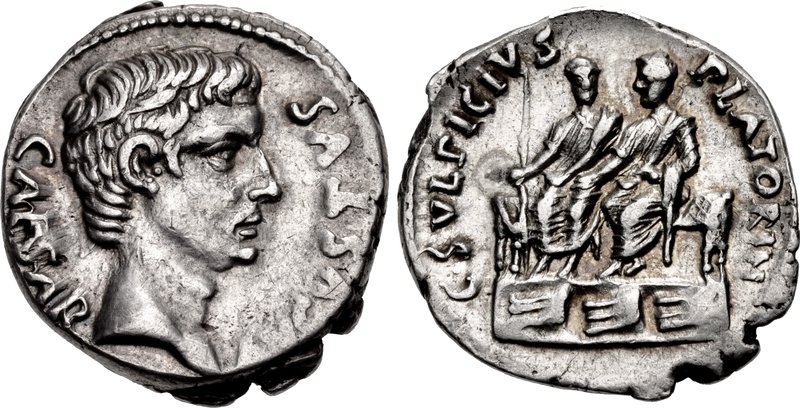
Coins with the portrait of Augustus on one side and Agrippa on the other were produced in the year of 13 BC under supervision of the same moneyer, C. Sulpicius Platorinus. Augustus and Agrippa appear bare-headed. Some other rarer issues, including an aureus (header photo), depict Agrippa wearing a combined mural & rostral crown which Augustus gave him.
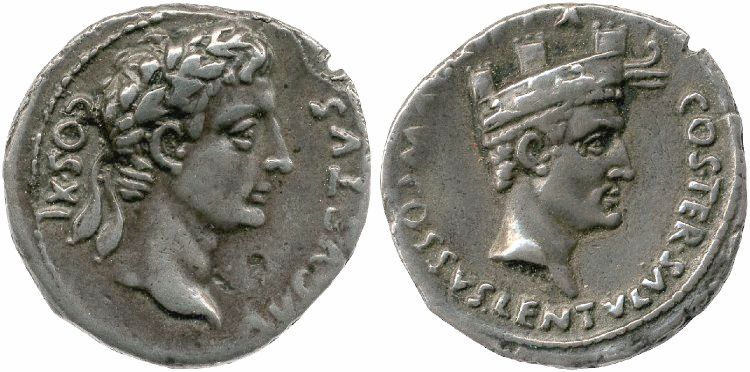
Agrippa was Augustus’s heir apparent and these coins emphasized his role. Unfortunately he died prematurely the year after. The coin struck in 12 BC – one year after previous ones – shows an unoccupied tribunal seat. This coin honors in a visual and emotional way the absence of the closest and most trustworthy friend of Octavian – Marcus Vipsanius Agrippa…
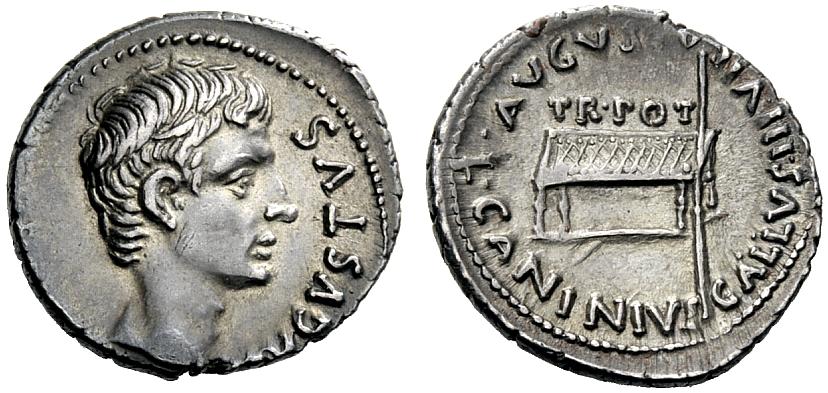
What to See in Nîmes now ?
Modern-day Nimes offers a remarkably rich array of ancient Roman architecture. The amphitheater near the heart of Nimes is one of the better preserved. It ranks as the seventh largest such structure from the ancient world. To the northwest of this theater, one will find the Maison Carée, a first-century temple originally dedicated to Augustus’ heirs Gaius and Lucius Caesar and recognized today as one of the best-preserved Roman temples outside of Rome itself. Those venturing out of the city can also find one of the best examples of ancient Roman engineering in the form of the aqueduct. The Pont du Gard, often associated with Nimes but situated roughly 30 kilometers away, has transversed the Gardon River since the first century CE.
Nîmes on Timetravelrome App:
The app offers a description of all main Roman monuments that can be seen in today’s Nimes. They are located on the map and and a description is provided for each place.
Sources:
1/ « La formule P-P des as de Nemausus », Revue des Études Anciennes, 1940
2/ « Auguste et l’Asie Mineure », textes recueillis par Laurence Cavalier et autres. Ausonius Editions, 1997
3/ “The Coinage of Nicopolis”, Colin Kraay, The Numismatic Chronicle (1966-) Vol. 16, 1976.
4/ “Marcus Agrippa. A Biography”, Meyer Reinhold. Geneva, New York: The W. F. Humphreys Press, 1932.
Author: Timetravelrome
Header image: Aureus. Obv: Head of Augustus, wearing oak-wreath, right. Rev: Head of Agrippa, wearing combined mural and rostral crown, right. Moneyer: C Sulpicius Platorinus. Soirce: British Museum.
